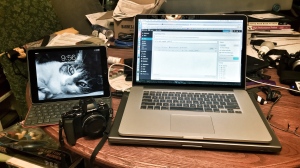 I’ve been a Windows user since Windows 1. I still have my Windows 1.03 SDK from the late 1980s, siting in its genuine cardboard box, complete with three-ring binders and 5 1/4″ floppy drives.
I’ve been a Windows user since Windows 1. I still have my Windows 1.03 SDK from the late 1980s, siting in its genuine cardboard box, complete with three-ring binders and 5 1/4″ floppy drives.
I have suffered through every release, including Windows 2, 286, 386, 3.0, 3.1, Windows for Workgroups 3.11, Windows 95/98/ME. I was a beta tester for both Windows NT 3.1 and Windows 95. Along with that cardboard box of Windows 1.03 SDK I have a huge crate filled with every Chicago/Windows 95 beta CDROM Microsoft ever shipped to me. And I faithfully installed every one and reported every problem I ran across. When it was finally released I personally drove down to a local FedEX office to pick up my gold copy. And I drove to Comdex Atlanta in 1995 to be at the local launch party.
And not just a Windows user, but a Windows developer, using Borland’s tools (Turbo Basic and C) through the Microsoft tools (VB, C, C++, etc), Java, Eclipse, and on and on. I used it, helped sell it, developed on it, and supported it across many decades.
With NT I have installed an run every single release and service pack since Windows NT 3.1, with the notable exception of Vista. I skipped from Windows XP to Windows 7. When Windows 8 came out I actually bought a full-blow Samsung 17″ notebook with Windows 8 installed. I loved it, far better than any previous release of Windows. And then a funny thing happened.
The majority of Windows users decided they didn’t like Windows 8, especially the start screen. No matter that it was dead simple to set it up to navigate between it and he desktop with mouse and keyboard, in spite of what its detractors said. The dissing of Windows 8 got so bad that Steven Sinofsky left Microsoft (quit or fired, it doesn’t matter). And Windows 8 began to change, to move back to what had come before in earlier releases. Microsoft went from being a leader to being a mere follower of public whim.
But I kept faithfully upgrading my Samsung through all the Windows 8 updates to Windows 8.1, and then when Windows 10 came out I upgraded to that. I even upgraded the 1TB spinning HD on the Samsung to a 1TB SDD, a Samsung 850 Pro. The change to SDD was amazing and breathed new life into the system as a whole.
A funny thing happened during the transition to Windows 10. Maybe it was the forty years of continuous Windows exposure (even more if you consider DOS before that). Maybe it was how Microsoft transitioned from Windows 8 to Windows 10. Or how Windows 10 just feels, well, odd. But within a month of upgrading to Windows 10 I bought my current Macbook Pro, and that’s the system I now turn to for day-to-day work as well as anything of significance. I still have the Samsung because it still has a number of important (“legacy”) applications and data I bring up from time to time. And I still faithfully power it on at least once/month to pick up the latest OS and Microsoft application updates. But all my interesting creative work (with the notable exception of Lightroom and photography) is done on my Mac, and special work with my Raspberry Pi is done with (ironically) an even older Samsung notebook running Ubuntu 15.10.
I’ve read the critics of Mac OS X complain rather noisily about how poorly it currently runs, but based on my experiences with all three (Windows, Mac OS X, and Linux), I find I turn to the Mac for nearly everything. It has its quirks to be sure, but every OS does.
I like where the Mac and OS X are at. Far better than where Windows 10 seems to be headed. If there was one word that summed up my overall feelings about the Mac and OS X, it would be quality. Windows 8 had it. Windows 10, not so much. The Mac is my insurance against the strange path Microsoft has plotted and seems to be headed down, a path I’m not comfortable following myself. I’m not accusing Microsoft of some sort of evil and nefarious plot like other noisy critics have cried and seem to continue to cry out. I’m just not all that crazy about it anymore. For me, if I want to do commercial OS development and support I can turn to Linux, and for the more complex work, I can turn to Mac OS X, which is a nice balance between standard Microsoft Office workflow and Unix/Linux tools and philosophy. Odd things are happening at Microsoft and as a consequence to Windows. Mac OS X is my safe harbor against the unknown and unknowable happening in Redmond.






You must be logged in to post a comment.